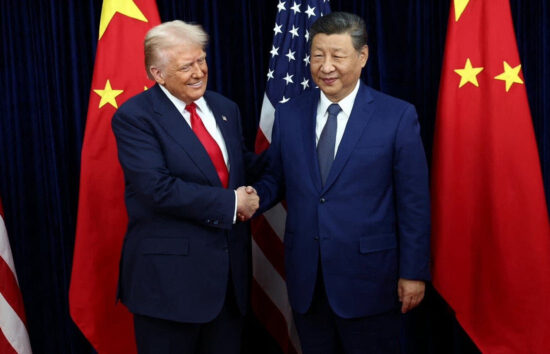 President Donald Trump and Chinese President Xi Jinping concluded a landmark meeting in Busan, South Korea on October 30, 2025—their first face-to-face encounter in six years—achieving significant progress on multiple fronts of the US-China trade conflict.Trump announced an immediate 10 percentage point reduction in tariffs on Chinese goods, lowering them from 57% to 47%. Additionally, fentanyl-related tariffs were cut from 20% to 10%, with Trump stating that Xi agreed to “work very hard to stop fentanyl” shipments to the United States.
President Donald Trump and Chinese President Xi Jinping concluded a landmark meeting in Busan, South Korea on October 30, 2025—their first face-to-face encounter in six years—achieving significant progress on multiple fronts of the US-China trade conflict.Trump announced an immediate 10 percentage point reduction in tariffs on Chinese goods, lowering them from 57% to 47%. Additionally, fentanyl-related tariffs were cut from 20% to 10%, with Trump stating that Xi agreed to “work very hard to stop fentanyl” shipments to the United States.
The two leaders clinched a one-year deal resolving the contentious rare earth dispute. “All the rare earths has been settled, and that’s for the world,” Trump told reporters aboard Air Force One, adding that the agreement would be renegotiated annually. Trump declared “there’s no roadblock from China anymore” on rare earth materials, which are critical for manufacturing in defense, automobiles, and consumer electronics.China pledged to resume purchasing “tremendous” amounts of American soybeans immediately. This marks a significant relief for US farmers who have suffered billions in losses after China halted soybean purchases in May 2025. Just ahead of the meeting, China’s state-owned COFCO purchased approximately 180,000 metric tons of US soybeans for December–January shipment—the first purchases from this year’s US harvest.
The closed-door talks lasted approximately one hour and 40 minutes at Gimhae Air Base in Busan, taking place on the sidelines of the Asia-Pacific Economic Cooperation (APEC) summit. Trump rated the meeting “12 out of 10” and described it as an “amazing meeting” that exceeded expectations.“We are going to issue a statement with some of the details but overall I guess on the scale of 0–10 with 10 being the best, the meeting was a 12,” Trump told reporters.
Ukraine Cooperation: Trump announced that he and Xi would “work together” on resolving the Ukraine conflict. “Ukraine came up very strongly. We talked about it for a long time, and we’re both going to work together to see if we can get something,” Trump stated.Future Diplomatic Engagement: Trump announced plans to visit China in April 2026, with Xi expected to visit the United States thereafter, either in Florida, Palm Beach, or Washington DC.Taiwan Not Discussed: Trump confirmed that Taiwan was not a topic of discussion during the meeting.

Technology and Semiconductors: The leaders discussed semiconductor trade, with Trump noting Beijing would be “talking to Nvidia and others about taking chips,” while clarifying that advanced Blackwell chips were not included.
Context and Significance
This meeting came after months of escalating trade tensions marked by retaliatory tariffs, export restrictions, and sanctions affecting sectors from advanced technology to international shipping. The global economy had been unsettled by these conflicts, making the meeting particularly crucial for both nations.
Prior to the summit, US Treasury Secretary Scott Bessent had signaled optimism, stating that negotiators had established a “framework” agreement addressing key concerns. Officials from both countries reported reaching a “consensus to address their respective concerns” before the face-to-face meeting.
The tone during opening remarks was conciliatory, with Xi emphasizing that “China and the United States should be partners and friends” and noting that while the two countries “do not always share the same perspective,” both nations could “thrive together”. Trump praised Xi as “the great leader of a great country” and expressed optimism about cultivating a “fantastic relationship for a long period of time”.
After the meeting concluded, Trump boarded Air Force One and departed South Korea immediately, while Xi remained for the APEC summit. Neither leader provided comments to the press immediately following their discussions.
Implications for India
The Busan breakthrough subtly reshapes the external environment in which India’s own pending trade agreement with the United States is being negotiated. The reduction of US tariffs on Chinese goods and the temporary resolution of the rare-earths dispute may narrow the competitive advantage that Indian exporters had gained from China’s higher trade barriers. Moreover, Washington’s renewed access to Chinese critical minerals could dampen immediate demand for alternative suppliers such as India.
However, this development also creates an incentive for New Delhi to accelerate the conclusion of its bilateral trade deal with Washington—before the US-China thaw stabilises into a longer-term arrangement. India can still position itself as a strategic partner in semiconductors, technology, and minerals diversification, provided it moves quickly to secure preferential access, investment, and technology-transfer commitments. A timely India–US accord would convert policy goodwill into tangible gains across manufacturing, electronics, and advanced materials, even as Washington and Beijing test the durability of their new understanding.
Medium-term Global Outlook
The Trump–Xi meeting has temporarily lowered the temperature in the world’s most consequential trade rivalry. With tariff relief, a rare-earths truce, and a restart to agricultural buying, Washington and Beijing have opened a narrow but important window for broader cooperation. For India and other emerging economies, the challenge now is to seize opportunity in stability—to move from being a beneficiary of confrontation to an active participant in a recalibrated global order.